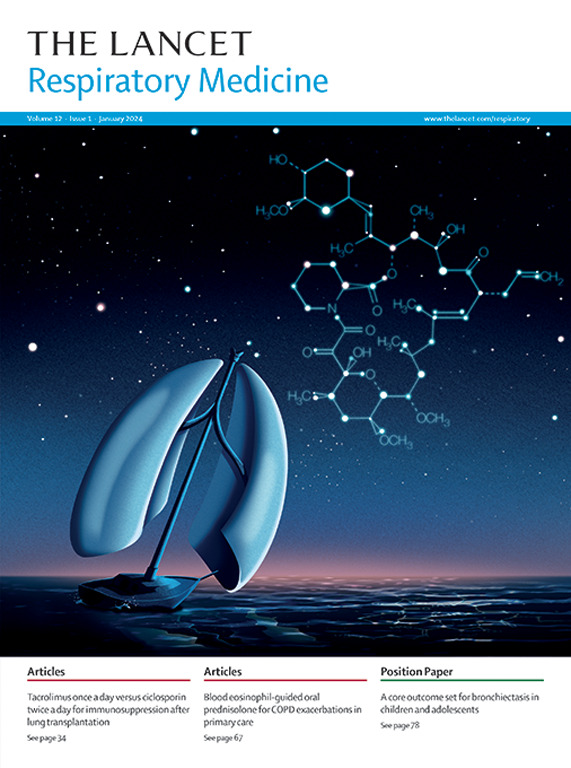Dupilumab与omalizumab在慢性鼻窦炎合并鼻息肉和共存哮喘(EVEREST)患者中的应用:一项多中心、随机、双盲、头对头的4期试验
IF 32.8
1区 医学
Q1 CRITICAL CARE MEDICINE
引用次数: 0
摘要
慢性鼻窦炎伴鼻息肉(CRSwNP)主要由2型炎症引起。生物制剂dupilumab和omalizumab分别靶向2型炎症的驱动因子和介质(白细胞介素[IL]-4/IL-13信号传导和免疫球蛋白E [IgE]),对治疗CRSwNP有效,但直接比较很少。在EVEREST(评估dupilumab与omalizumab的治疗反应)中,我们的目的是比较dupilumab和omalizumab在患有轻度、中度或重度哮喘的严重CRSwNP患者中的疗效和安全性。severest是一项国际性、随机、双盲、4期试验,在17个国家的100家医院或临床中心进行。选择耳鼻喉科、肺炎科、过敏症科和免疫学家执业的地点;需要先前进行过双盲研究;并且需要鼻内窥镜检查和心电图仪。符合条件的患者年龄为18岁或以上,患有严重不受控制的CRSwNP(鼻息肉评分为5分或以上[每个鼻孔≥2分]),筛查前至少8周有鼻塞和嗅觉丧失症状,医生诊断为哮喘。患者被随机分配(1:1)接受每2周300 mg的杜匹单抗皮下给药,或每2周或每4周给予奥玛珠单抗体重分级和ige分级给药,同时使用糠酸莫米松鼻喷雾剂。患者和调查人员对研究药物不知情。主要终点是24周内窥镜鼻息肉评分和宾夕法尼亚大学嗅觉识别测试(UPSIT)的基线变化。在意向治疗人群中评估了疗效,在接受至少一剂研究药物的患者中评估了安全性。该试验已在ClinicalTrials.gov注册,编号NCT04998604。在2021年9月27日至2024年12月27日期间,819人接受了纳入研究的筛查,459人被排除在外(最常见的筛查失败是:167名患者未达到鼻息肉评分≥5分或没有持续的鼻塞和嗅觉丧失症状,114名患者未达到支气管扩张剂前FEV1≤85%预测正常,99名患者不符合资格(根据omalizumab给药),360名参与者被随机分配(181名分配到dupilumab组,179名分配到omalizumab组)。360名参与者中,男性198人(55%),女性162人(45%),总体样本平均年龄52岁(SD 13.1)。在第24周的所有主要和次要疗效终点上,dupilumab的改善明显大于omalizumab。dupilumab与omalizumab从基线变化的最小二乘平均差异为:鼻息肉评分-1·60 (95% CI -1·96至-1·25;p< 0.0001)和UPSIT评分8.0(6.3至9.7;p< 0.0001)。dupilumab组179名受试者中有115名(64%)报告了治疗中出现的不良事件,omalizumab组173名受试者中有116名(67%)报告了治疗中出现的不良事件,其中最常见的是鼻咽炎、意外用药过量、头痛、上呼吸道感染和咳嗽。研究中没有死亡病例。在严重CRSwNP合并哮喘患者中,dupilumab优于omalizumab。这些发现支持dupilumab对2型呼吸系统疾病患者的疗效,以及dupilumab和omalizumab的已知安全性,并且可以在临床实践中为CRSwNP和哮喘患者提供更好的治疗靶向。资助赛诺菲和Regeneron制药公司。本文章由计算机程序翻译,如有差异,请以英文原文为准。
Dupilumab versus omalizumab in patients with chronic rhinosinusitis with nasal polyps and coexisting asthma (EVEREST): a multicentre, randomised, double-blind, head-to-head phase 4 trial
Background
Chronic rhinosinusitis with nasal polyps (CRSwNP) is predominantly driven by type 2 inflammation. The biologics dupilumab and omalizumab, which target drivers and mediators of type 2 inflammation (interleukin [IL]-4/IL-13 signaling and immunoglobulin E [IgE], respectively), are efficacious in treating CRSwNP but direct comparisons are few. In EVEREST (EValuating trEatment RESponses of dupilumab versus omalizumab), the first head-to-head trial in respiratory biologics, we aimed to compare the efficacy and safety of dupilumab and omalizumab in patients with severe CRSwNP who had mild, moderate, or severe asthma.Methods
EVEREST was an international, randomised, double-blind, phase 4 trial, conducted at 100 hospitals or clinical centres in 17 countries. Sites were selected with otolaryngology, pneumologist, allergist, and immunologist practices; needed to have previously conducted double-blind studies; and were required have nasal endoscopy and electrocardiogram machines. Eligible patients aged 18 years or older with severe uncontrolled CRSwNP (with a nasal polyp score of 5 or more [and ≥2 for each nostril]), symptoms of nasal congestion and loss of smell for at least 8 weeks before screening, and physician-diagnosed asthma. Patients were randomly assigned (1:1) to subcutaneous dupilumab 300 mg every 2 weeks or omalizumab weight-tiered and IgE-tiered dosing every 2 weeks or 4 weeks for 24 weeks, with background mometasone furoate nasal spray. Patients and investigators were masked to the study drugs. Primary endpoints were change from baseline in endoscopic nasal polyp score and University of Pennsylvania Smell Identification Test (UPSIT) at 24 weeks. Efficacy was assessed in the intention-to-treat population and safety was assessed in patients who received at least one dose of study medication. The trial was registered at ClinicalTrials.gov, NCT04998604.Findings
Between Sept 27, 2021, and Dec 27, 2024, 819 individuals were screened for study inclusion, 459 were excluded (most common screen failures were: 167 did not meet nasal polyp score ≥5 or did not have ongoing symptoms of nasal congestion and loss of smell, 114 did not meet pre-bronchodilator FEV1 ≤85% predicted normal, and 99 did not meet eligibility as per omalizumab drug-dosing), and 360 participants were randomly assigned (181 assigned to the dupilumab group and 179 assigned to the omalizumab group). Of the 360 participants, 198 (55%) participants were male, 162 (45%) were female, and the mean age of the total population sample was 52 years (SD 13·1). Improvements were significantly greater with dupilumab than omalizumab for all primary and secondary efficacy endpoints at week 24. Least squares mean differences in change from baseline dupilumab over omalizumab were: nasal polyp score –1·60 (95% CI –1·96 to –1·25; p<0·0001) and UPSIT 8·0 (6·3 to 9·7; p<0·0001). 115 (64%) of 179 participants in the dupilumab group and 116 (67%) of 173 participants in the omalizumab group reported treatment-emergent adverse events, the most common of which were nasopharyngitis, accidental overdose, headache, upper respiratory tract infection, and cough. There were no deaths in the study.Interpretation
Dupilumab was superior to omalizumab in patients with severe CRSwNP and coexisting asthma. These findings support the efficacy of dupilumab in patients with type 2 respiratory diseases versus an active biologic comparator, the known safety profiles of dupilumab and omalizumab, and could enable better treatment targeting for patients with CRSwNP and asthma in clinical practice.Funding
Sanofi and Regeneron Pharmaceuticals.求助全文
通过发布文献求助,成功后即可免费获取论文全文。
去求助
来源期刊

Lancet Respiratory Medicine
RESPIRATORY SYSTEM-RESPIRATORY SYSTEM
CiteScore
87.10
自引率
0.70%
发文量
572
期刊介绍:
The Lancet Respiratory Medicine is a renowned journal specializing in respiratory medicine and critical care. Our publication features original research that aims to advocate for change or shed light on clinical practices in the field. Additionally, we provide informative reviews on various topics related to respiratory medicine and critical care, ensuring a comprehensive coverage of the subject.
The journal covers a wide range of topics including but not limited to asthma, acute respiratory distress syndrome (ARDS), chronic obstructive pulmonary disease (COPD), tobacco control, intensive care medicine, lung cancer, cystic fibrosis, pneumonia, sarcoidosis, sepsis, mesothelioma, sleep medicine, thoracic and reconstructive surgery, tuberculosis, palliative medicine, influenza, pulmonary hypertension, pulmonary vascular disease, and respiratory infections. By encompassing such a broad spectrum of subjects, we strive to address the diverse needs and interests of our readership.
 求助内容:
求助内容: 应助结果提醒方式:
应助结果提醒方式:


